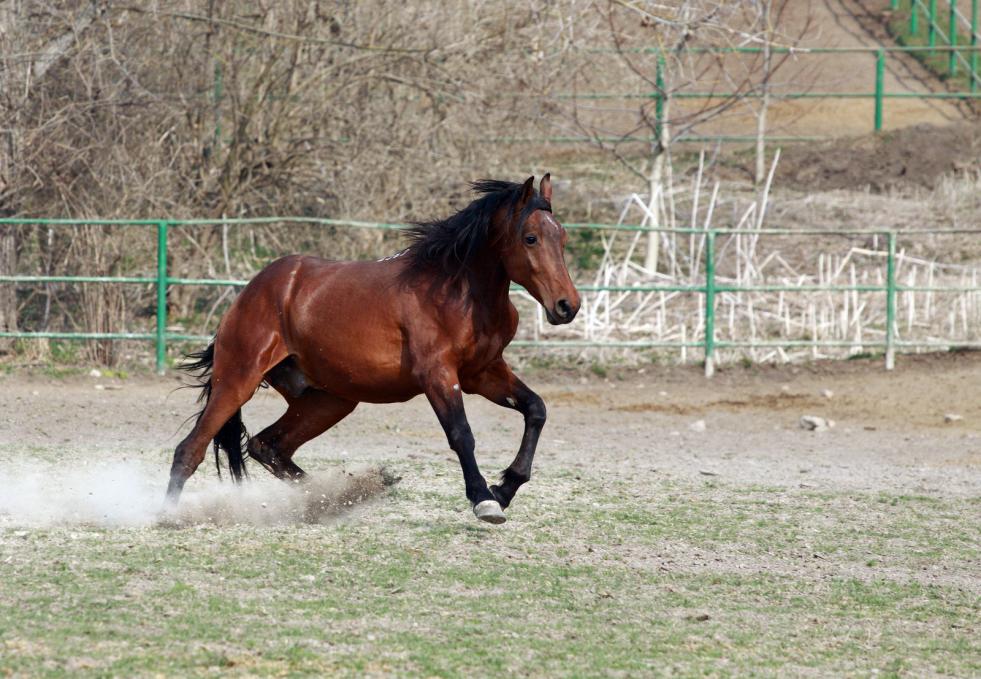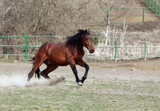Horse Gait is a pattern of movements, a manner of walking on foot or sequence of steps by which equines move forward. Different breeds can perform a variety of gaits depending on their ability and level of training.
In the US, usually called as ‘gaited’, these horses can perform not only the basic gaits, but also artificial or trained gaits such as running walk, pace, slow gait, and rack.
Basic gaits - walk, trot, gallop, canter, and back, - are knows as natural gaits.
Below we will focus on the natural gaits that horses can perform.
Natural Gaits
Gallop, trot, walk, back, and canter are the basic movements that can be carried out by stock horses. Paint Horse, Appaloosa, and Quarter Horse are well suited for working with livestock or other various farm animals.
Additionally, English and Hunter horses such as Morgan, Thoroughbred, Saddle bred, and Arabian, can also execute such movements.
1. Gallop
In this movement, there is an increase in the length of strides and suspension period. Here, horses can’t move their legs diagonally because their speed is really fast.
It is a four-beat gait, where foreleg or inner leg leads, depending on whether the movement is in a straight line or not. Since there is a greater weight on the leading leg, the horses change legs in between the gallop.
2. Trot
Trot is a two-beat gait where the movements of the diagonal legs are harmonized. It is a gait that is in between a walk and a run. Horse’s legs move in diagonal pairs but not quite simultaneously. The sequence of the footfall is right hind with left fore and left hind with right fore.
Average trot speed is 8 miles per hour. A slower trot is called a jog.
3. Walk
This movement comprises of four legs moving in equal intervals of time. It is the gait of four-beat thus four different footstep sounds can be easily recognized when a horse is walking on the ground. The footfall order is left fore, right hind, right fore, left hind.
4. Canter
Based on the three-beat gait, it is a controlled movement which begins with a foreleg leading and another foreleg following with the diagonal hind leg. The order of the footfall is the left front leading with right hind, then right fore with left hind, after which the left front follows.
The speed of the canter varies between 10-17 miles per hour which depends on the length of the stride and suspension. A variation of canter but slower at pace, is called a loop. It’s done at an approximate speed of 8-12 miles per hour.
5. Back
This two beat diagonal gait is performed by the horses themselves, with no involvement of the rider. The pattern in this movement is somewhat similar to the trot, but in a backward direction. Which means the back footfall is right front with left hind and right hind with left front.
There is still a disagreement between which movement to consider artificial or trained, and which is natural. The difference in the gaits can be explained through the natural environment as well as the breed and its genetics. However, if you want your horse to have a particular gait, with some effort and proper care you can get them to learn new footfalls pretty quickly.
If your horse struggles to perform certain movements, don’t force it but, instead, try to do a different gait. Lastly, it is crucial to be patient with your horse as you both go through the motion of learning these movements.
Always remember that any activity requires your horse to spend a lot of energy. Hence, a horse that is physically properly taken care of, well fed,hydrated, and using a horse probiotic will grant you with a satisfying training process. If your horse is worked especially hard during any training session, they may benefit from supplements to help aid in faster recovery. There are a variety of horse supplements available today on the market from those to help promote sweating and replace lost electrolytes, to those that help build muscle and increase stamina. All horses are unique and most will benefit from a supplement depending on their current activity level and the quality of their forage.
When searching for a horse supplement, be sure to read the labels for proper dosage and ingredients, and always consult with your veterinarian if you have any questions.
Remember to ensure your own and equine’s safety throughout any process and have fun!!


